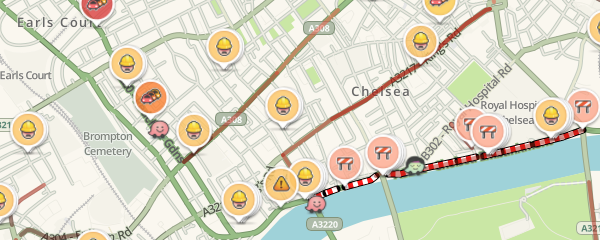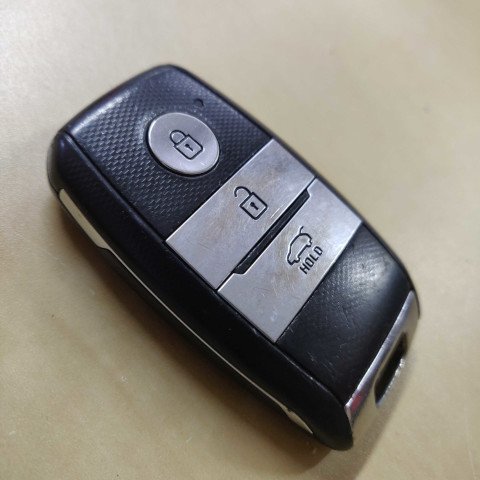Feb 26, 2018
Whether it is cruising down Route 66 while exploring the zanier side of American pop culture or rambling through Europe exploring castles, vineyards, and exciting nightlife, nothing beats the romance and sheer sense of freedom of a road trip!
Guidebooks and good old-fashioned maps printed on paper still have their uses, but these days it would be insane not take advantage of that internet-connected computer that sits in your pocket (or on your dashboard).
1. A GPS Navigation App
If there is one bit of modern technology that can convert even the hard-bitten technophobe, it is GPS. And why spend money on an expensive dedicated GPS unit when your phone has a much better processor, a higher resolution screen, and can run the much more sophisticated software.
Waze has its fans, thanks mainly to crowdsourced traffic reports, but the indisputable king of GPS apps is Google Maps. I am not a big fan of Google, but Google Maps is a wonder of our times. It can also do a lot more than provide beautifully rendered turn-by-turn navigation to your destination after factoring the latest traffic reports into its calculations.
It’s comprehensive and accurate maps cover 220 countries and territories, and you can easily search for nearby restaurants, banks, petrol stations, and business you will need on your journey. And when you decide to pull over for sightseeing, Google Maps offers great walking guidance and public transport, complete, with 360 degrees street view to help ensure you never get lost.
Maps can also be downloaded for offline use for when out of intent range or travelling in countries where it is prohibitively expensive to use your mobile data allowance. Just download them in advance on your hotel or any café’s WiFi.
Handy hint: The jury is out over whether toll roads end up costing you more money, but for many Brits, they are a bane of travelling abroad. In fact, even if they do save you a little money, travelling by smaller roads is invariably more scenic.
You can tell Google Maps to avoid toll roads by first selecting your destination -> Options (the 3 dots next to “Your Location”) -> Route Options -> Avoid toll roads. You can also avoid motorways and ferries in this way.
If you have an Android device then you probably already have Google Maps on it, but if not then you can get it here. Google Maps is also available for iOS.
As a privacy advocate, I feel duty-bound to point out that Google Maps is not a great choice when it comes to privacy. OsmAnd is great open source alternative that leverages the excellent crowdsourced OpenStreetMap project. It offers offline navigation and voice guidance. OsmAnd is available for iOS and Android.

2. A VPN app
A Virtual Private Network (VPN) is the Swiss army knife of internet privacy and security. If you are not sure what a VPN is or why you should have one in general (and you should!), please see here.
“Yes,” I can hear you say, “VPNs are amazing, but why do I need one on my road trip?”
Well, for a start, all the usual reasons. A VPN will prevent your mobile provider and government from spying on everything you do online. You may not care about this if roaming abroad as you might at home, but there is a principle involved here!
A VPN protects you against WiFi criminal hackers, which is invaluable if roaming data charges force you to rely on hotel and café WiFi for your internet aces. And it is not just hackers you need worry about! After all, the people who run the public WiFi networks cannot always be trusted with your privacy either.
A VPN is also handy for keeping up with TV shows while you are away from home and the ability to plonk the kids in front of CBeebies on BBC iPlayer on long journeys or when enjoying a well-earned glass of wine after a day’s driving a lifesaver.
If your road trip is somewhere exotic, a VPN is great for overcoming local internet censorship. Indeed, in even most countries, hotels and the suchlike restrict what you can access over their WiFi.
Most VPN services offer dedicated apps for both iOS and Android, although it is not hard to manually configure them either. For a list of great VPN options for both platforms, please check out 5 Best VPNs For iPhone and 5 Best Android VPNs on BestVPN.com.
3. A Music app
If you are going on a road trip then you need some funky tunes to listen to as the scenery rolls by! When it comes to music apps, there are two main approaches you can take. You can take your music with you, or you can stream it.
Local music players
Taking your music with you has a great deal to recommend it while travelling. You don’t need to worry about expensive data roaming charges, or the music grinding to a halt when mobile data coverage gets patchy. If you don’t want to grow bored of your music quickly, you’ll need a lot of it. This means taking a phone with plenty of storage.
I won’t even bother trying to dissuade iPhone users from using iTunes, and why should I? It is a great app (on Apple platforms). Android users almost certainly have a music app pre-installed on their phone by its manufacturer, but audiophiles’ go-to app of choice is the all-singing and all–dancing Poweramp (Paid app).
Alternatively, open source fans may prefer Vanilla Music (Android only).
Streaming music players
Steaming music is very useful if your device has limited storage and if you like a great deal of flexibility in what you listen to. Data charges are the main concern, although you can always download tracks locally on your hotel’s WiFi for off-line listening during the day.
Europeans (including Brits for now) should also be aware that by EU law, roaming charges have been abolished. This means you do not need to pay any additional tariffs on your regular data plan when travelling to another European country.
Again, I am not even going to bother trying to dissuade iPhone users from using iTunes with the Apple Music streaming service. Spotify is also another popular choice for both iOS and Android users, but I am going to recommend Google Play Music.
A Google Play Music subscription provides unlimited access to a ridiculously large music library, and you can pin any track for local playback. The reason I recommend it, however, is that you can upload up to 50,000 of your own tracks for free. You can then listen to these to your heart’s content without paying Google a penny!
4. An app that will find you somewhere to stay
One of the best things about a good road trip is that you have the freedom to roam. Find an idyllic beach, why not stay for a couple of extra days? A local tells you about a fantastic well-kept secret, why not go off and explore it?
This probably does mean, though, that you don’t know where you will end up spending each night. Fortunately, apps can take the guesswork out finding good accommodation at short notice. This can also be a lifesaver in high season when just rocking up on the doorstep after a long day’s travelling is likely to see you caught-out for somewhere to stay.
Airbnb has revolutionised the holiday accommodation market. Using the Airbnb app (iOS and Android) you can find and rent out everything from entire villas to cheap rooms in family homes. This is a great way to meet locals, absorb the culture, and get inside information on the best places to visit during your stay!
A wealth of Airbnb accommodation is available just about everywhere in the world. The app will show you plenty of photos, maps, and user reviews, so you can find exactly what you want and will experience no nasty surprises when you get there!
Although a bit niche, I am also going to recommend Park4Night (iOS and Android) to the more adventurous out there whom road trip in camper vans and don’t like being tied to official campsites. Park4Night lets you search specific areas or routes for off-road “wild camping” spots, official free rest areas, vineyards that allow you stay overnight, and the suchlike.
Sites are crowdsourced and usually include photos and users’ comments. Coverage in the UK and Europe is particularly great, but spots in North America are also listed.
5. PetrolPrices
Well, why wouldn’t we recommend our app? If you are travelling in the UK then the PetrolPrices app (iOS and Android), is essential for keeping costs down during your trip. It displays all 8,490 UK petrol forecourts, with prices that are updated daily 365 days a year.
Of course, if you are travelling outside the UK then the PetrolPrices app is less useful (at least for now!).
Although it pains me somewhat to say it, if travelling in a country where you don’t know the language, then Google Translate (iOS and Android) is pretty much essential.
Its’ translations are not always perfect, but they are good enough to see you through most situations. The app can translate voice conversations in realtime, and you can simply point your phone’s camera at a menu to take the hassle out of actually feeding yourself while abroad.
Simply put, Google Translate is a wonder of modern technology, and nothing else comes even close to doing what it does. If you prefer to learn a bit of language before visiting somewhere (or brush up on a rusty one), then Duolingo (Android) is very good and is completely free.
Conclusion
There are few areas of life where the benefits of modern technology are more obvious than while travelling. The apps listed above make going on a road trip much easier than it used to be and remove much of the uncertainty.
I am aware some may think the uncertain factor is what makes doing a road trip fun, but trust me – getting lost, having your bank details stolen by hackers, or finding yourself without a bed for the night is not fun!
So better living and more fun through technology. Yay! Have a great trip!
Author: Douglas Crawford.
Dec 27, 2017
With over a million cars being fitted with telematics boxes, also known as black boxes, by insurance companies, there is now plenty of data which shows exactly how British motorists are driving and can help people to think of ways to make the roads safer for all who use them.
What do they do and who uses them?
Billions of miles have been travelled by cars fitted with a telematics device over the last decade and they can gather data on a variety of factors including speed, cornering, braking and accelerating, plus pinpoint the type of road that the individual is driving on.
These boxes have predominantly been used by new drivers in a bid to prove that they are sensible behind the wheel so that their insurance premiums go down over time, but people of all ages and experience can have one fitted in their vehicle.
Britain’s largest telematics insurance provider, Insurethebox, has gathered 3 billion miles worth of driving data and associated claims since 2010, and along with similar providers Marmalade and Coverbox they have shared this to reveal information about the “real driving habits” of British motorists.
Evidence that has been gathered
The data has shown that 17-year-old drivers who have just started their driving experience are actually safer than 18 and 19-year-olds who have held their licenses for a bit longer. This could be because new drivers are still getting used to driving and are being more cautious, whereas those who are slightly older have had time to gain confidence which is why their driving deteriorates over the age of 18.
Those with 2 – 3 years of driving experience under their belt are the worst speeding offenders, whereas 17-year-olds actually drive at a relatively modest speed.
The difference between how males and females drive has always been a hot topic of conversation, and black boxes have supported the myth that women drive more carefully, at lower speeds, and have fewer accidents than men. Their average claim also costs less at £2345 compared to £2566 but, due to EU rules, insurance companies aren’t allowed to base their quotes on gender like they used to.
Conclusions
The most dangerous road type for young drivers are country roads with a 60mph speed limit as it is often not safe to drive anywhere close to 60mph but a lack of experience means that this is not always understood. With narrow lanes, blind corners and slow-moving vehicles to contend with these roads are actually more dangerous than the motorways that so many new drivers are scared to use.
Gov.uk data has shown that 80% of young driver fatalities occur on rural roads so it is important that those new to driving understand that just because the road signs show 60mph it doesn’t mean that it is safe to drive at that speed.
It has also been found that a driver’s behaviour leading up to an accident is often erratic from the moment that they leave the house. This suggests that if people have had an argument or are feeling frustrated when they get into their vehicle it could have a negative effect on their driving which results in them having an accident.
Getting a quote
Occupation is also taken into consideration when working out insurance quotes, and telematics data has supported this by showing that motor racing drivers and funfair employees are among the most risky drivers whereas NHS workers are among the safest on the roads. It was also found that gamers are relatively safe drivers whereas those who read as a hobby are often more risky.
As well as providing an interesting insight into “real driving habits” black boxes can save young drivers up to 37% on their car insurance if they drive carefully and follow the laws of the roads, and 40% of new motorists are already taking advantage of this in a bid to reduce their insurance premium.
(Image credit – InsureTheBox)
Would you be willing to have a black box fitted to monitor your driving behaviour and iron out any bad habits? Let us know in the comments below.
Nov 22, 2017
The race towards successful autonomous – or driverless – cars continues at high speed. However, the insurance industry has raised concerns that the UK is woefully under-prepared for their arrival. Insurance professionals are calling for the urgent overhauling of the laws dealing with insurance in order to review the issue of autonomous cars, which are expected to be on UK roads by 2021.
Liability issues
Questions around liability have already been one of the stumbling blocks for the roll-out of driverless cars, especially during the period where they won’t be entirely driverless. The driver will be legally in charge – even when the vehicle is using autopilot. Insurers are concerned that this could lead to confusion over responsibility and could mean drivers face uninsured losses.
Chris Grayling, Secretary of State for Transport, said that the government would rule that future policies must cover injuries to all parties where driverless vehicles are involved. In a speech to insurers, he went on to say that self-driving cars would be in use by 2021 and that a new compulsory insurance framework would be required to cover these vehicles, including the issue of drivers having legal control.
In addition, the Thatcham Research Centre, a motoring body funded by the insurance industry, has urged the government to speed up the reforms currently covered under the Automated and Electric Vehicles bill. The research organisation believes that, while self-driving cars will eventually cut road accidents, the current situation with semi-autonomous vehicles will confuse people.
(Credit – Flickr User)
On the road
The Audi A8 was launched in June. It has an autopilot mode in which the car can navigate through slow-moving traffic, in addition to being able to park itself. However, the legal and insurance implications of this have yet to be confirmed. Drivers in the front seat have their hands on the wheel during these manoeuvres, but the insurance industry has raised concerns about when the driver takes back full control.
The A8 is due to be on the road next year. It has reached a level of autonomy classed by engineers as level 3. This means the car does most of the tasks, though the driver is required to intervene at certain points. According to the Association of British Insurers, many people wrongly think the vehicle can manage the whole journey, which isn’t the case.
Autonomous checklist
Thatcham has drawn up a ten-point checklist of features that it believes manufacturers of autonomous cars should follow. These include transparent signalling of independent capabilities and systems to ensure that handover back to the driver is clear to understand. It would certainly help deal with potential grey areas where a driver would not be insured for their injuries when a car was driving autonomously, although passengers would.
Currently, the levels of automation recognised in the industry include:
Level 0 – no automation
Level 1 – driver assistant
Level 2 – partial automation
Level 3 – conditional automation
Level 4 – high automation
Level 5 – full automation
Level 3 upwards involves the automated driving system monitoring the driving environment to make decisions about driving.
Driverless in the US
Testing of driverless cars in the US is well ahead of what the UK has experienced. Both the national and state governments seem keen to continue advancing the tests. Driverless cars have hit several milestones already, including the first without a backup driver in Arizona. Google’s parent company Alphabet has also announced a fleet of modified Chrysler Pacifica minivans, which will undergo testing on the roads of Phoenix.
The US authorities are already looking at solutions for problems we have yet to consider here in the UK. For example, how do we handle driverless cars on the motorway? And how will they interact with smart motorways? In the US, the authorities are considering having driverless car lanes on some interstates. But how will the vehicles handle traffic jams or roadworks? While the growth of the driverless cars continues, there are still many questions to be answered and the UK needs to push ahead urgently in order to be ready for the arrival of this technology.
Why is the UK lagging behind in its approach to driverless car adoption? How can we do more to ensure we’re fully prepared for the motoring technology of the future? Leave a comment to share your views.





